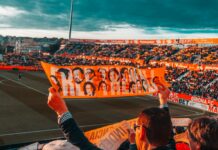In the Ruhr area is not the paradox that the object of philosophy, but in everyday life. Joseph Roth, author of novels such as “job” and “The Capuchin crypt” and a Virtuoso of the sharp-eyed Abgesangs, wrote in 1926: “The country always wants to start his Land – and can’t… It’s not a landscape, it is a kind of elongated Stadtschaft, industr ieschaft…”. The portraitist of this later as the “city” referred to Scenery, this conglomerate of fields, open areas and old village cores, the hugged in addition to giant industrial plants, in the shadow of suburbs straggled similar settlements as later, the weeds in the bombed-out streets, was Albert Renger-Patzsch was born in 1897 in Würzburg, died as one of the most important photographers of the New objectivity, 1966 in Wamel.
Hubert Spiegel
editor in the features section.
F. A. Z.
Renger-Patzsch, a sought-after commercial photographer, this landscape, which was no and no is dedicated to be the largest free project: Its between 1927 and 1935, created “the Ruhr area photographs” include about a hundred and fifty designs. Two years ago, about a hundred of them were shown in the Pinakothek der Moderne in Munich. Now they are seen in the former coal washery of the Zollverein coal mine in Essen to be complemented by a further two hundred shots from the Ruhr area, which were unpublished. Almost all of the deductions come from the Hand of the photographer and are of outstanding quality. Thus, the Ruhr Museum in Essen shows on its special exhibition area not only the most comprehensive exhibition on the work of Renger-Patzsch, but in the Moment of closure of the last coal mine for a fascinating look back on what has been the Ruhr area.
the Aura of The Timeless
But Renger-Patzschs photographs actually show Joseph Roth’s “Stadtschaft” how was she then? First of all, it is Work in the style of the New objectivity, “puristic, timeless, cold and technical” had to be, as the curator Stefanie Grebe in the excellent catalog writes and the they were also. But when Renger-says Patzsch on his method of working in retrospect, the chosen image must be in agreement with a prior to the recording of the created “image of Thought”, the own Detail to negate and as a “new organism” as “from the Random-exempt” will appear, then, suggests that the photographer used a own concept of realism: It is not documented right where it was.
images
Renger-Patzsch shows the Metropolitan area, at that time had four million inhabitants, almost without exception, without people. The streets: empty. Houses: as uninhabited. Industrial buildings: clinically clean. With a variety of Vertical light poles, fence stakes, posts, poles, tree trunks – divided he his shots, gives you a structure that is, in fact, freed from the Accidental. The recordings breathe the Aura of the Overtime, and exceed the purely documentary: aestheticizing what is, as it could and it should be left to the will of the artist forever. Clean the space of any historicity.
Transformation in permanence
Renger-Patzsch came in 1929 in the Ruhr area, lived in Essen, the garden city Margarethenhöhe, and worked at the Museum Folkwang. About his relationship to the Nazis, surprisingly little is known. Politics and war do not appear in the factory. With one exception: In March 1943, photographed Renger-Patzsch bomb damage in food, especially at Münster in the end of the war ninety percent of the destroyed downtown. As in the case of an attack in the October of the following year, the Museum Folkwang is taken, a fall of 18,000 Negatives from the photographer to the extinguishing water to the victims. At the end of 1944, Alfred Renger leaves to eat-Patzsch, and moved with his family to Wamel.




